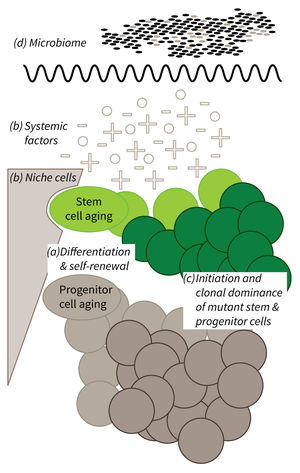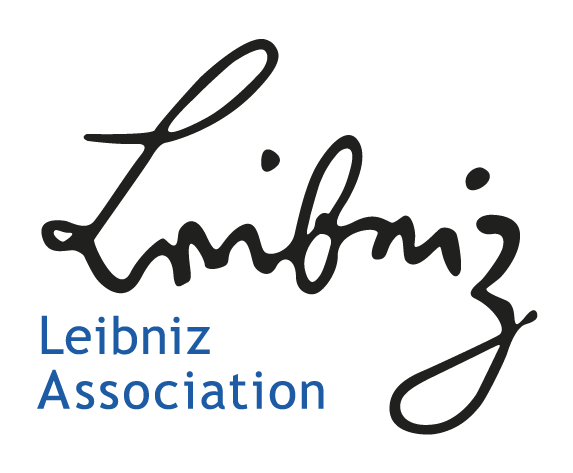Subarea 1: Stem Cell Aging
The individual research groups within Subarea 1 investigate the causes and consequences of stem cell aging. The research work spans from basic model organisms over genetic mouse models up to humanized mouse models engrafted with human stem cells.
According to the FLI, with the closure of two groups since 2016 the representation of invertebrate models of stem cell research was reduced in Subarea 1. The institute presumes that the recruitment of new groups should fill this gap.
The research is defined by four focus areas:
- Cell-intrinsic mechanisms limiting the function of aging stem and progenitor cells,
- Aging-associated alterations of stem cell niches and the systemic environment,
- Mechanisms of clonal selection and epigenetic drifts in stem cell aging, and
- Microbiota- and metabolism-induced impairments in stem cell function during aging (in context of the new focus area Microbiota and Aging currently being built up within Subarea 2).
Research focus of Subarea 1.
a) It is currently not well understood what mechanisms impair cellular functions in aging. b) The relative contribution of niche cells and systemic acting factors on stem cell aging have yet to be determined in different tissues. c) Clonal expansion of mutant cells associates with disease development in aging humans. Mechanistically, the process remains poorly understood. Changes in color intensity depict clonal dominance originating from stem (green) or progenitor cells (gray). d) Emerging evidences indicate that aging associated alter ations in microbiota influence stem cell function and vice versa.
Publications
(since 2016)
2022
- Characterization of Novel α-Mangostin and Paeonol Derivatives With Cancer-Selective Cytotoxicity.
Nunna S, Huang YP, Rasa M, Krepelova A, Annunziata F, Adam L, Käppel S, Hsu MH, Neri F
Mol Cancer Ther 2022, 21(2), 257-70 - Peripheral blasts are associated with responses to ruxolitinib and outcomes in patients with chronic-phase myelofibrosis.
Palandri F, Bartoletti D, Iurlo A, Bonifacio M, Abruzzese E, Caocci G, Elli EM, Auteri G, Tiribelli M, Polverelli N, Miglino M, Heidel FH, Tieghi A, Benevolo G, Beggiato E, Fava C, Cavazzini F, Pugliese N, Binotto G, Bosi C, Martino B, Crugnola M, Ottaviani E, Micucci G, Trawinska MM, Cuneo A, Bocchia M, Krampera M, Pane F, Lemoli RM, Cilloni D, Vianelli N, Cavo M, Palumbo GA, Breccia M
Cancer 2022, 128(13), 2449-54 - YBX1 mediates translation of oncogenic transcripts to control cell competition in AML.
Perner F, Schnoeder TM, Xiong Y, Jayavelu AK, Mashamba N, Santamaria NT, Huber N, Todorova K, Hatton C, Perner B, Eifert T, Murphy C, Hartmann M, Hoell JI, Schröder N, Brandt S, Hochhaus A, Mertens PR, Mann M, Armstrong SA, Mandinova A, Heidel FH
Leukemia 2022, 36(2), 426-37 - Inflammaging is driven by upregulation of innate immune receptors and systemic interferon signaling and is ameliorated by dietary restriction.
Rasa* SMM, Annunziata* F, Krepelova A, Nunna S, Omrani O, Gebert N, Adam L, Käppel S, Höhn S, Donati G, Jurkowski TP, Rudolph KL, Ori A, Neri F
Cell Rep 2022, 39(13), 111017 * equal contribution - The hairpin region of WNT7A is sufficient for binding to the Frizzled7 receptor and to elicit signaling in myogenic cells
Schmidt M, Poser C, Janster C, von Maltzahn J
Comput Struct Biotechnol J 2022, 20 - Association of Telomere Length With Risk of Disease and Mortality.
Schneider CV, Schneider KM, Teumer A, Rudolph KL, Hartmann D, Rader DJ, Strnad P
JAMA INTERN MED 2022, 182(3), 291-300 - PLCG1 is required for AML1-ETO leukemia stem cell self-renewal.
Schnoeder TM, Schwarzer A, Jayavelu AK, Hsu CJ, Kirkpatrick J, Döhner K, Perner F, Eifert T, Huber N, Arreba-Tutusaus P, Dolnik A, Assi SA, Nafria M, Jiang L, Dai YT, Chen Z, Chen SJ, Kellaway SG, Ptasinska A, Ng ES, Stanley EG, Elefanty AG, Buschbeck M, Bierhoff H, Brodt S, Matziolis G, Fischer KD, Hochhaus A, Chen CW, Heidenreich O, Mann M, Lane SW, Bullinger L, Ori A, Eyss Bv, Bonifer C, Heidel F
Blood 2022, 139(7), 1080-97 - Disrupting PTPRJ transmembrane-mediated oligomerization counteracts oncogenic receptor tyrosine kinase FLT3 ITD.
Schwarz M, Rizzo S, Paz WE, Kresinsky A, Thévenin D, Müller JP
Front Oncol 2022, 12, 1017947 - pH-sensitive packaging of cationic particles by an anionic block copolymer shell.
Solomun JI, Martin L, Mapfumo P, Moek E, Amro E, Becker F, Tuempel S, Hoeppener S, Rudolph KL, Traeger A
J Nanobiotechnology 2022, 20(1), 336 - Age-dependent effects of Igf2bp2 on gene regulation, function, and aging of hematopoietic stem cells in mice.
Suo M, Rommelfanger MK, Chen Y, Amro EM, Han B, Chen Z, Szafranski K, Chakkarappan SR, Boehm BO, MacLean AL, Rudolph KL
Blood 2022, 139(17), 2653-65









